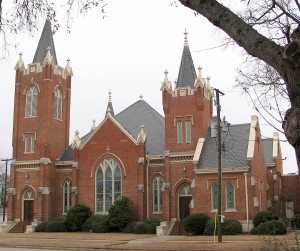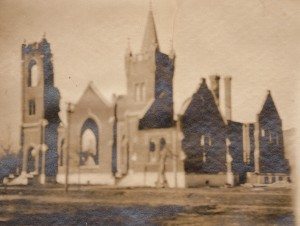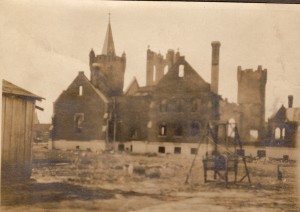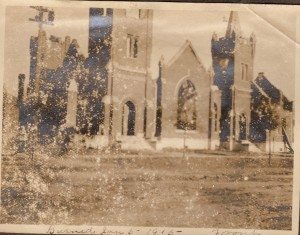Main Street United Methodist Church will hold its centennial celebration in honor of 100 years in their current church building on May 8th.

The day will begin at 9:30 a.m. with a gathering and greeting coffee hour in Asbury Hall.
The Festival Worship will begin at 10:30 a.m. in the sanctuary.
The worship will feature the inaugural performance of their commissioned anthem, “I Am Coming Soon,” by Larry Shackley, performed by the Charles Wesley Choir, with additional voices and instrumentalists. 
The centennial message, “Beauty Out of the Ashes,” will be given by Dr. Norman Rogers, son of the late George Lester and Mary White Rogers.
The updated history of the church written by John Braddy will be unveiled.

The Fire-January 6, 1915
One hundred years ago on Tuesday, January 6, 1915 the original Main Street United Methodist Church built at 401 East Main Street was destroyed by fire, approximately 8 months after its dedication.
To give you some background into what life was like then, bread was 6¢/loaf, bacon was 27¢/pound, and milk was 36¢/gallon. There were a few Model T automobiles around as production had started in 1908. The City of Dillon had been founded in 1888, approximately 27 years earlier. Dillon County had been created in 1910. World War 1 had started in 1914 but the US would not enter it until 1917. The boll weevil was on the way but would not arrive until 1919 in Dillon County. Tobacco production was getting started in our area and several warehouses had been built by local business men to sell the crop. Dillon County was growing!
What caused the fire? Dolph Braddy’s history of Main Street Methodist Church (1892-1963) indicates that the fire may have been an electrical fire. Rev. J. A. Cauthen, the preacher in charge, and Mr. Muller were in the church around 11 AM the day of the fire but did not smell any smoke. When the fire was discovered by them around 12 Noon it was only in one place and they put it out, left the building, and went home. Approximately 10 minutes later the whole top of the Sunday School, which was located where Asbury Hall is today, was burning. The Fire Department fought hard but it was too late. Some men went in the sanctuary to try to save things in it. When they opened the door the smoke was so thick that they had to tie handkerchiefs around their noses and mouths. Some of the firemen came close to succumbing to the dense smoke. They were able to save both of the pulpit furniture sets and only about seven or eight pews because each one was attached to the floor with seven or eight screws. Boy Scouts and some men carried everything out of the parsonage (located where the paved parking lot is today). The Fire Department had to keep the parsonage wet so that it wouldn’t catch fire.
Mr. W. T. (Thad) Bethea, Chairman of the Board of Stewards (now Administrative Council), wrote the Southern Christian Advocate (now S. C. United Methodist Advocate) that “we are ruined, we do not know what to do”. Two hours later he wrote the Advocate that the “Building Committee had just met and we have wired our contractor to come back, as we shall build at once. That is Dillon’s way”. Thad lived directly across Main Street from the church and was an undertaker.
The architect for the church was Oliver Duke Wheeler of Wheeler and Stern of Charlotte, N. C. He designed many churches in North and South Carolina in locations such as Fayetteville, NC, Shelby, NC, and Laurinburg, NC.
The entire block that the church is located on was originally owned by A. J. C. Cottingham. He deeded one half of the block to the Southern M. E. Church South on June 14, 1914. It is interesting to note that Mr. Cottingham reserved for himself in the deed during his lifetime access to and benefits of an artesian well located on the lot. Also, at the same time the first church building was being constructed, Mr. Cottingham had the same contractor build a residence for him on the Main and 8th Avenue corner of the lot (where the basketball court is now located). It was later sold to J. B. Gibson and then sold again to the church for a parsonage after the original parsonage that faced Harrison Street was demolished in 1956.
According to an article in the January 21, 1915 issue of the “Dillon Herald”, the manufacturer of the original pipe organ, Henry Pilcher’s Sons of Louisville, KY built a replacement organ for the church. The firm built over 1,800 organs for churches, concert halls, and universities across the country. Unfortunately in 1944 the factory closed and the assets were sold to the M. P. Möller Organ Company of Hagerstown, Maryland.
One final note. At a meeting of the Board of Stewards on January 18, 1915, the following committee was appointed to have supervision of the rebuilding: E. L. Moore, Chairman; T. W. Bethea; W. J. Adams; and E. R. Hamer.
The rebuilt church was completed on May 12, 1916.
The congregation is 124 years old. Services prior to 1914 were held in a church at a different location in Dillon.



